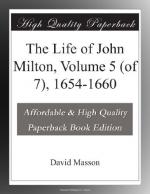with Henry Hills and John Field, his Highness’s
Printers, to see to the strict enforcement in future
of the restrictions of certain cited Press Acts,—to
wit, the ordinance of the Long Parliament of June 14,
1643 (that against which Milton had written his
Areopagitica),
the similar ordinance of the same Parliament of date
Sept. 28, 1647, the Act of the Rump Parliament of
Sept. 20, 1649 (Bradshaw’s Press Act of the
first year of the Commonwealth), and the renewal of
the same Jan. 7, 1652-3. Had this been all, one
might have inferred nothing more than one of those
occasional panics about Press licentiousness from
the recurrence of which even Milton’s reasoning
had never been able to free the Government with which
he was connected. But at the same meeting it
was referred to Lord Fleetwood, Lord Wolseley, Lord
Pickering, Lord Jones, Lord Desborough, Lord Viscount
Lisle, and Lord Strickland, or to any two of them,
“to consider of fit persons to be added for
licensing of books and to report the names of such
persons to the Council.” This was distinctly
retrogressive; and the regret of Milton must have been
none the less because four of the Committee that were
to find the new licensers were men he had named in
his
Defensio Secunda as heroes of the Commonwealth,
and because, as appears from a marginal jotting to
the minute as it stands in the Council Order Books,
the man thought of at once for one of the new licensers,
or as the person fittest to be first consulted in
the business, was Marchamont Needham. After all,
it may have been, like some of the previous movements
for press-regulation, only a push from Paternoster
Row in defence of the legitimate book-trade, and the
main intention of the Council itself may have been
against pamphlets like
Killing no Murder or
publications of the indecent order.[1]
[Footnote 1: Council Order Books of dates, and
Nickolis’s Milton State Papers, 143-144
(the last for Malyn’s Letter about Nayler).
For previous Press Acts referred to by the Council,
see ante Vol. III. 266-271, and Vol. IV.
116-118.]
O how stable and grand seemed the Protectorate in
the month of July 1658! Rebellion at home in
all its varieties quashed once more, and now, as it
might seem, for ever; the threatened invasion of the
Spaniards and Charles Stuart dissipated into ridicule;
a footing acquired on the Continent, and 6000 Englishmen
stationed there in arms; Foreign Powers, with Louis
XIV. at their head, obeisant to the very ground whenever
they turned their gaze towards the British Islands,
and dreading the next bolt from the Protector’s
hands; those hands evidently toying with several new
bolts and poising them towards the parts of Europe
for which they were intended; great schemes, besides,
for England, Scotland, Ireland, and the Colonies,
in that inventive brain! All this, we say, in
July 1658, by which time also it was known that the
Protector, so far from fearing to face a new Parliament,




